We travelled to France on Thursday 29th June. After a good trip from the tunnel, and some minor (?) detours, found our base for the next two nights, a little gite on the outskirts of La Couture, about 8 kilometres to the north of Bethune on the road to Armentieres. We ate that night, in great style, at a roadside Friterie, a typical meal of cheeseburger and chips (our French is not good and it was the only thing on the menu in English).
Next morning we awoke early and, having breakfasted, this time truly in French style, we set off for the first of our locations for the day, Richebourg St Vaast Post Military Cemetery. Having driven some thirty kilometres to achieve eight the previous day, we had decided to locate the venue for the Service of Commemoration, to be held that evening, to ensure we knew how to get there by the appointed time of 18.00hrs.
After one false start we found the cemetery, and as we parked the car, noticed an empty Landrover bearing British number plates just a few yards away. We spent a few moments in quiet contemplation and then set about our first task for the day, which was to photograph the graves of those killed in action on 30th June 1916, together with any who died of wounds later. It was whilst thus employed that we became aware that there was someone sitting quietly on a bench at the rear of the cemetery but, not wishing to disturb his meditation, we carried on with our task.
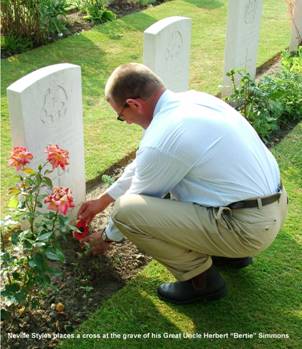
After some while our sitter stirred and came over to ask if we knew what was happening at the evening service of remembrance. Having admitted that we knew no more than he did, we got onto the subject of the reason for his being there. It turned out that Neville had driven overnight from Norfolk to take part in the service because his Great Uncle Herbert “Bertie” Simmons had been killed at the Battle of the Boar’s Head and was buried in this very cemetery.
Having briefly discussed our plans for the day, our new friend asked if he might tag along and so our party of three became a group of four.
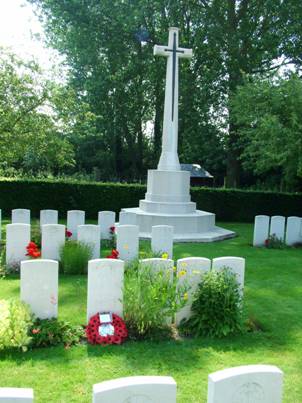
Next stop on our itinerary was The Royal Irish Rifles Cemetery at Laventie, just a few miles up the road. We had just arrived there and were in the process of writing the card of the wreath which we intended to lay on the grave of CSM Nelson Carter, “A” Coy. 12th Battalion, Royal Sussex Regiment, who won a posthumous V. C. for his actions on 30th June 1916, when another car drew up with UK number plates, out of which piled four chaps, two of whom we recognised as Paul Reed, the tour guide, and Geoff Bridger of the Western Front Association. They were down on the Somme for the 1st of July and had taken time out to visit Carter’s grave.
There were gardeners of the Commonwealth Wargraves Commission working in the cemetery when we arrived. As usual the cemetery was perfectly groomed. Carter’s grave was obscured by a growth of flowers but, after a few words with the groundsmen, the plant was pruned back to allow full view of the headstone. As we laid our wreath they respectfully downed tools and joined us in observing two minutes silence.
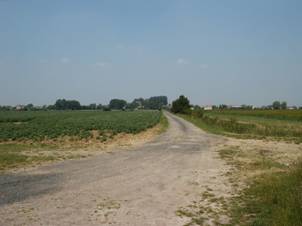
From Laventie we drove down towards La Bassee, passing through Neuve Chapelle to Port Arthur, where Edmund Blunden had been on the morning of the Boar’s Head action.
After a little searching, we indentified the area of the Boar’s Head and spent about an hour on the site of the 1916 action which is, by the way, only a few hundred metres from the area where the 2nd and 5th Battalions had fought during the Battle of Aubers Ridge in May 1915. A local resident, who we met and spoke with whilst trying to ensure we were actually at the right spot, was kind enough to show us a small collection of items found nearby, most of which were from the Great War period.
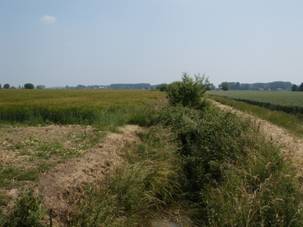
Having had a good look around, we realised that it was well after 13.00hrs, and decided to look for a place to eat. Finally we found somewhere that was open and with a few words of English from our host and equally limited French from us, we ordered a meal. In typical French style the meal was somewhat leisurely, and we emerged from the bistro at about 15.30hrs, to return to our billet to prepare for the evening commemoration.
The Commemoration Ceremony.
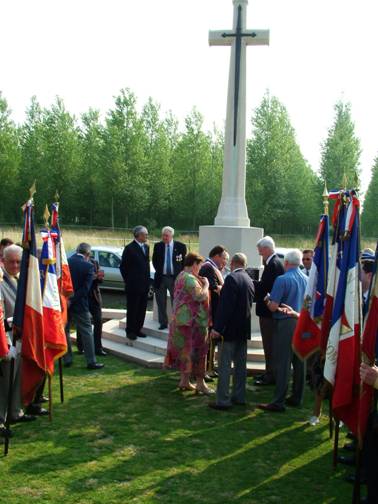
Setting out in good time, our preparations in the morning meant that we arrived at Richebourg St. Vaast Post Military Cemetery at around 17.45, and were amazed to see a considerable number of cars already there.
As we parked we were aware of what was a fair crowd of people in the cemetery, many wearing medals and carrying standards. Our number plates and the Royal Sussex wreath that we were carrying made it fairly obvious that we were British and we were quickly approached and made most welcomed by Anne-Lise, our contact at the Office of the Mayor of Aubers, without whose help the commemoration would not have happened.
We were introduced to Mrs Annie Lung, Mayor of Aubers, and also to the local teacher who was to act as interpreter. Whilst awaiting the arrival of the Mayor of Richebourg we were chatting with the interpreter and telling her about our chance meeting that morning with Neville, and had just said that he had probably travelled the furthest to be there, when we heard someone say “I can beat that, I come from Gloucester!”
As six o’clock approached the Mayor arrived and the eighteen standard bearers formed up in two rows from the Cross to the Altar Stone. The Mayor of Aubers made a speech of welcome, which was duly interpreted for our benefit. Gerard Delahahaye, Mayor of Richebourg, then spoke about the battle and of the numbers of men who died in the early morning of 30th June 1916 and said that he considered it an honour to lead this, the first act of commemoration in eighty-nine years, to such brave men.
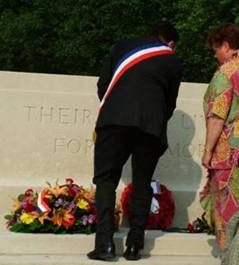
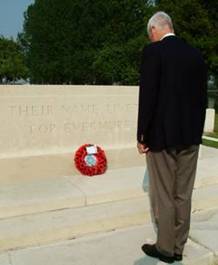
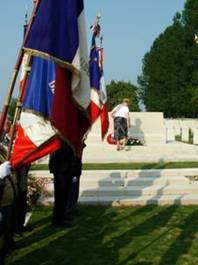
Three wreaths were then laid for The Royal Sussex Regiment, the village of Aubers and finally for Richebourg, following which a bugler played the French version of the Last Post. There was a two minute silence, which concluded with Reveille. The National Anthem was played, following which our hosts sung, with great gusto, the Marseillese.
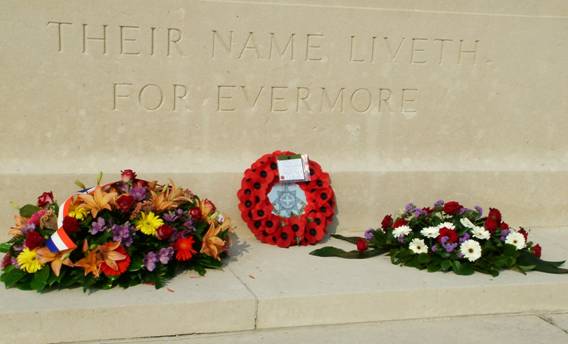
The main commemoration over, M. Le Maire asked that we accompany him to thank the bugler and standard bearers for coming. This done, we then presented him with a cut glass paperweight, a gift from the Mayor of Worthing, Major Tom Wye M.B.E., reminding him that Worthing and Richebourg had been closely associated after the war, and a letter which read:
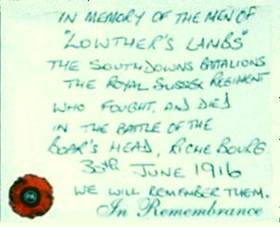
“The Mayor and people of Worthing send greetings to the Mayor and people of Richebourg l’Avoué, with this small token of friendship, on the occasion of the commemoration of this ninetieth anniversary of the Battle of the Boar’s Head.
After the Great War ended, we were linked in rebuilding both bricks and mortar, and a way of life, which had been put aside for the duration of the war.
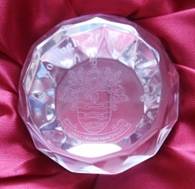
In July of 1921 M. Paul Boulainguez, the Mayor of Richebourg, and his son Charles, visited Worthing. On the Sunday M. Boulainguez laid a wreath at Worthing’s new war memorial. In a short speech he said that he considered it a sacred duty to render homage to those sons of Worthing who died for their country and now lay under French soil.
We thank you for continuing to honour the men of Worthing, and of all Sussex, who remain with you in Richebourg, especially on this 30th of June, 2006, the ninetieth anniversary of their sacrifice, which took them from this life into the next.”
The Mayor was clearly moved by this, and said that he felt deeply honoured.
Worthing lost thirty men at the Battle of the Boar’s Head, including Private John Searle, possibly the youngest of those who died that day, at just fifteen and three quarter years of age. He had joined up in April the preceding year. Also killed were Reginald Charles Manwaring, of Broadwater, age eighteen, enlisted at sixteen. The Blaker family lost two sons that day, Leonard is buried at Richebourg St. Vaast, Frank is commemorated on the Loos Memorial to the missing. The Pannell family lost three of their four sons at The Boar’s Head, Charles (SD/4063, 13th Bn.), and William (SD/5108 12th Bn.), brother Alfred (SD/5107 13th Bn.) was initially reported missing, but later confirmed killed in action. All three brothers’ names appear on the Loos Memorial. Worthing, like so many other Sussex towns and villages, has all too many reasons to remember the Boar’s Head.

Our day was concluded by an invitation to the Village Community Centre for drinks. The Mayor showed us an aerial photograph in his office on which many Great War landmarks could be clearly identified, including of course The Boar’s Head, and also a framed scroll detailing the men of the Cinque Ports Battalion from Wadhurst, with whom Aubers is twinned, who were killed at the Battle of Aubers Ridge. After some conversation it became apparent that M. Delahaye would like to do something similar for the Battle of the Boar’s Head, and indeed that the commemoration is likely to become an annual event, a sentiment echoed by several of the Richebourg residents we met that day.
We returned to our billet that night knowing that, on the eve of the Somme Commemorations, for some of us the men of Lowther’s Lamb had not been forgotten.
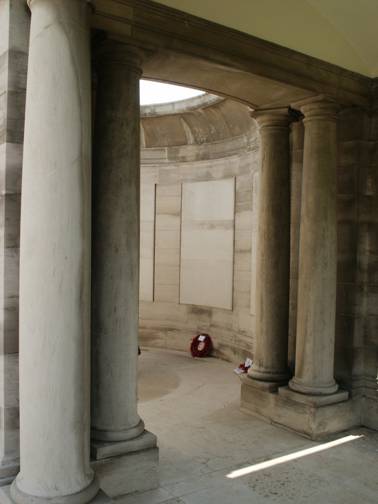
On the following day we journeyed down to Loos-en-Gohelle, where we easily located the Dud Corner Cemetery. There we laid a wreath, dedicated to Private John Searle, and all those of the Southdowns Battalions who were lost at the Boar’s Head, below his name on the panels recording those missing following that action whose bodies were never recovered. We spent some time in the cemetery recording the graves of the Royal Sussex men buried there, including Sgt Harry Wells V.C., before moving on to the Cabaret Rouge Cemetery at Souchez, the last of the major cemeteries where Southdowns Brigade men killed at the Boar’s Head are buried, again recording all their graves.
Standing in the Richebourg St Vaast Cemetery, one could be forgiven for underestimating the scale of the loss by the Southdowners that early morning in 1916, but, after visiting The Loos Memorial and Cabaret Rouge, the enormity of it all is something which leaves an indelible imprint on ones mind. Only on returning home, and starting the work of recording the details of each cemetery or memorial, did the impact of that one battle, lasting just four and half hours, on the families of Sussex finally bring home why June 30th 1916 became known as “the day Sussex died”.
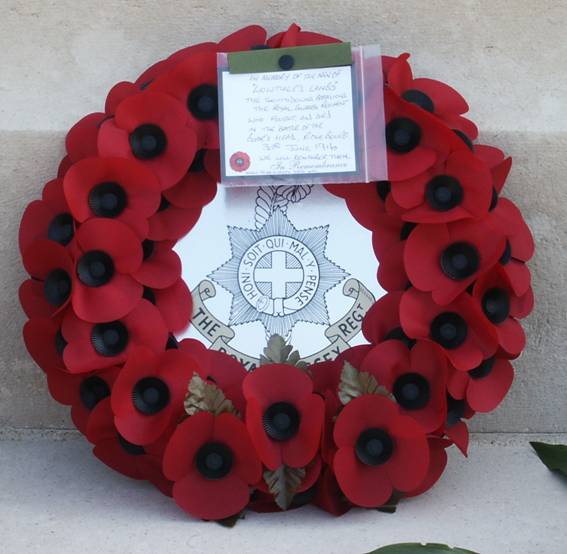

Since the ninetieth anniversary we have remembered them.
We will endeavour to continue to do so at Richebourg St. Vaast Post Military Cemetery
At 17.00hrs on the last Saturday in June each year until the 100th anniversary
The 100th Aniversary Commemoration will be held at 17.00hrs on 30th June 2016.
God willing we will be there.
The major Boar’s Head Cemeteries are:






